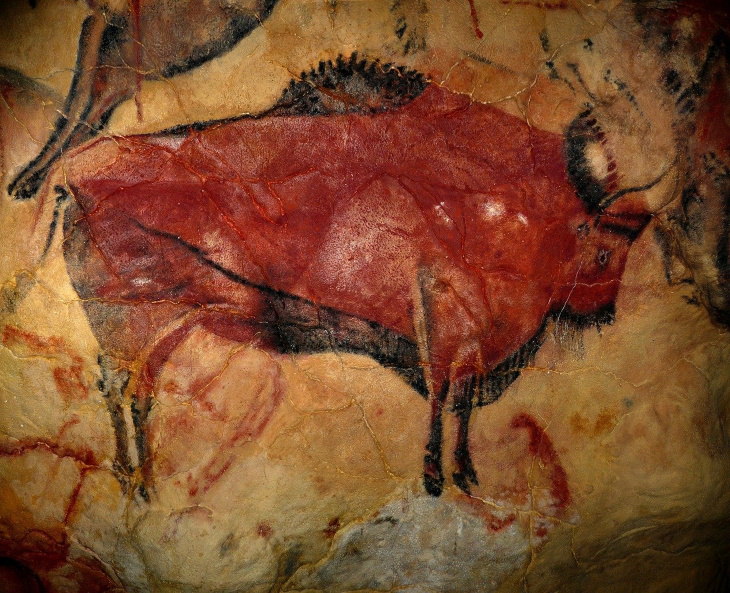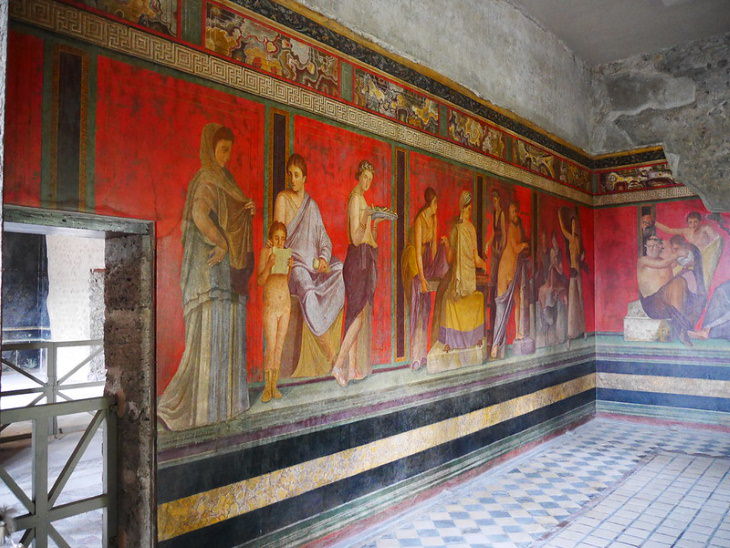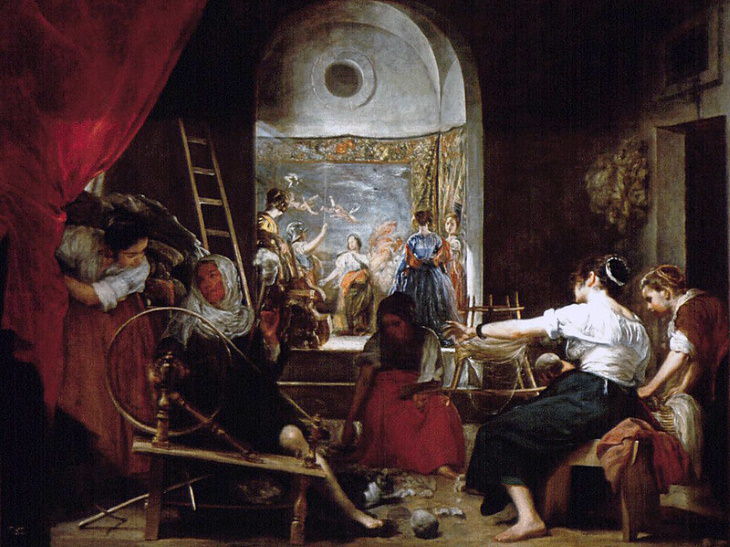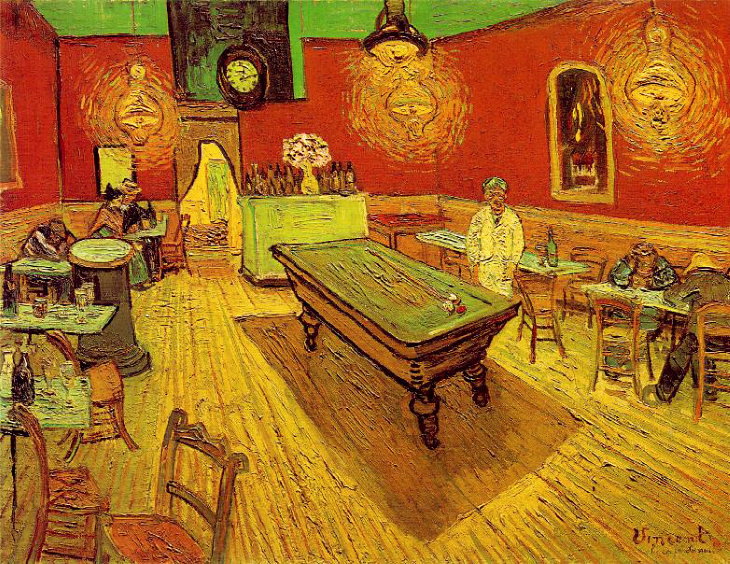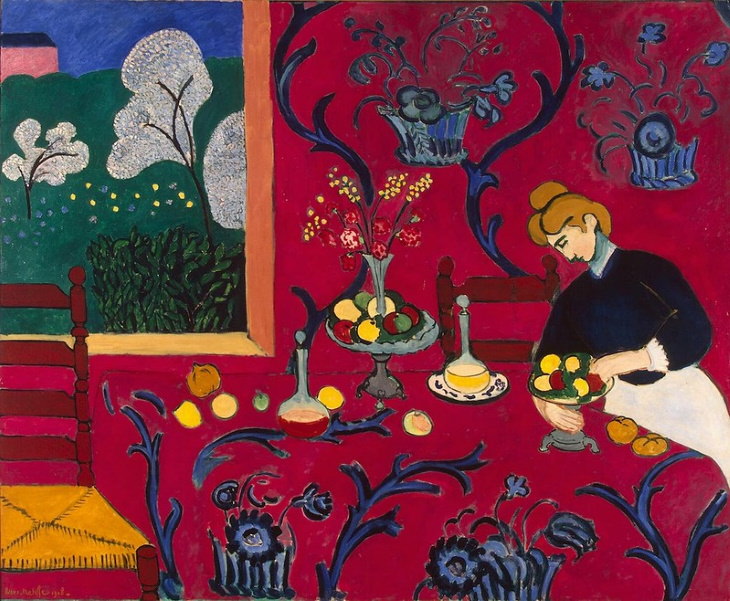Red Ochre - the mother of all reds
A cave painting in Altamira, Spain (15.000 - 16.500 BC)
The first artworks in history were painted in red. These early cave paintings, be it the wildlife depicted at the Altamira Cave in Spain or the hand-prints at Cueva de Los Manos in Argentina were all made using the same material – ochre. This naturally occurring pigment ranges from yellowish-brown to an earthy red in hue, with the latter being by far the earliest one used.
There’s even evidence of Neanderthals using this pigment in the area we now know as the Netherlands 250,000 years ago. Even back then, ochre had a deep symbolic meaning. Red ochre is often found near the graves of these early humans, which points to the fact that the pigment was likely used to mark the graves of the departed or applied onto their hair and body as a mourning ritual.
Thousands of years later, red ochre was also used by the Ancient Egyptians to dye the skin red, and Ancient Chinese potters used red ochre to produce black and red pottery. But by that time, some ancient civilizations already had a bigger arsenal of red dyes. They came to develop a new, brighter red pigment, too - cinnabar.
Cinnabar - the red of Ancient Civilizations
The pigment known as cinnabar has a much brighter and more intense hue than its predecessor. Also known as mercuric sulfide, cinnabar is made of ground-up cinnabar crystals, mining and working with which is highly toxic. Both Ancient Egyptians and Ancient Romans loved the bright red color and used it in home decoration, clothing, and face painting. Examples of brilliantly preserved cinnabar murals can be seen in Pompeii even today.
Like prehistoric people, Ancient Romans gave the color a deep symbolic meaning. Red was associated with blood, but not necessarily with mourning and death. It was also the color of love, fertility, and courage. Red was the color of heroes and Mars, the god of war. Red tunics were the uniform of Roman soldiers, and generals wore scarlet cloaks. Victorious gladiators were painted red and paraded through the city of Rome.
In the east, cinnabar has been synonymous with the famous Chinese lacquer pottery since the 12th century. In Ancient China, the color red was and still is associated with good fortune, joy, and happiness. Traditional Chinese wedding gowns are crimson, and red was the only color banned at funerals.
Vermilion - the first synthetic red pigment
Portrait of Cardinal Pietro Bembo by Titian (c. 1540)
Vermillion was one of the rarest and most exclusive pigments for centuries. The first vermillion pigments were made of cinnabar in China, but over time, Chinese scholars learned to produce synthetic vermilion. The vibrant red paint came to be known as Chinese Red.
Chinese Red traveled through the Silk Road. Arab merchants started selling the new red pigment throughout Europe in the Middle Ages. At this time, vermillion was as pricy as gold leaf in Europe, so only the most important letters of the biggest religious manuscripts were decorated with this rare and costly paint.
As you may know, red is one of the most prominent colors at the Forbidden City in China. The gates of the imperial city were completely painted in red, for example. Knowing the cost of the pigment used to decorate this 15th-century imperial palace reveals its true level of luxury.
In Medieval and Renaissance Europe, red became strongly associated with Jesus Christ's sacrifice and the Blood of Christ. To this day, red is the color of the robes of Catholic cardinals, a tradition that began in Medieval France.
Since the vast majority of European art was centered around Catholicism at the time, vermillion was also a prominent color in Renaissance art. Unfortunately, vermillion turns a dark purplish-brown color over time, which is why the majority of paintings don’t feature the bright red now (unless they were professionally restored, of course).
Carmine - the pigment that came from the New World
Arachne by Diego Velázquez (1659) Image Source: cea+/ Flickr
Carmine, also known as ‘crimson lake,’ is an organic pigment made of dried and crushed cochineal, small bugs that live on cacti. Spanish conquistadors saw the brilliant red colors of Aztec art and architecture in the 16th century and started exporting them to Europe almost immediately.
The valuable export was surpassed in prize only by silver and gold. Nearly all of the great 15-16th century painters - such as Velázquez, Rembrandt, Anthony van Dyck, Rubens, and Vermeer - used carmine in their art.
European aristocrats fell in love with the pigment too: they dyed their clothing with cochineal as a signifier of their wealth and blue blood. The pigment has a deep crimson color, but it must be kept away from the light to prevent fading. Since carmine is an organic dye, it’s used in cosmetics and foods to this day.
Minium - Van Gogh’s red
Minium, or ‘red lead,’ was the go-to red pigment for Vincent van Gogh. Since the lead compounds present in minium make it a highly toxic material, some of Van Gogh’s physical and mental health issues have been attributed to lead poisoning. But red lead has another annoying tendency - it whitens in sunlight over time, which is why many of the red elements in Van Gogh’s paintings have faded over time.
But Van Gogh was hardly the only artist to use minium. Red lead is one of the first synthetic red pigments. It leans orange, which is why it was often used by Romans in marble, but also by the Indian and Mughal artists of the 17-18th centuries. At roughly the same time, the French Revolution broke out in Europe. Many of the revolutionaries wore red caps and carried red flags. Red became the color of protest, revolution, and socialism - a tendency that persists until today.
Cadmium red - the new red
The 20th century brought technological advances, including new pigments. In 1907, cadmium red became commercially available. It was one of the most prominent colors used by modernist painters, an intense pigment known for its colorfastness. Henri Matisse was one of the first major proponents of this new pigment, but famous artists of the 20th century, including the famous pop artist Andy Warhol, used the pigment.
Since then, some believed that the pigment was toxic, but research proved that the concentration of cadmium in the pigment is very low, and these concerns don’t hold water. As a result, cadmium red is still being sold worldwide. All in all, the history of red is a complex and fascinating one. The color has dominated human visual culture for millennia and continues to do so even today.
Share this interesting information with those who love history and art!

